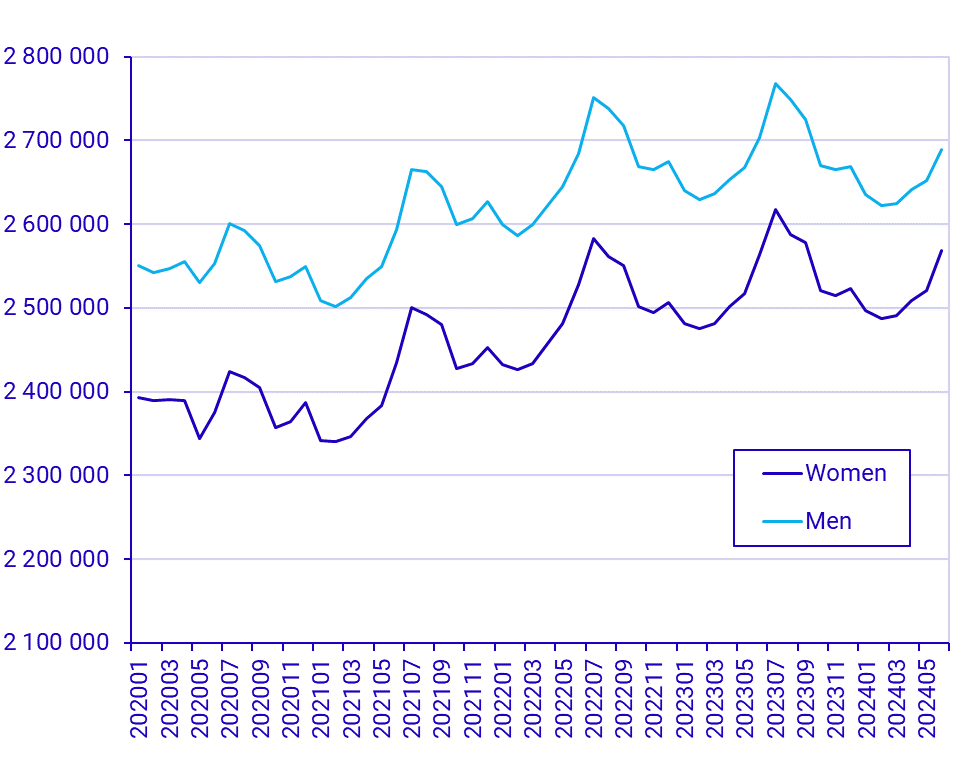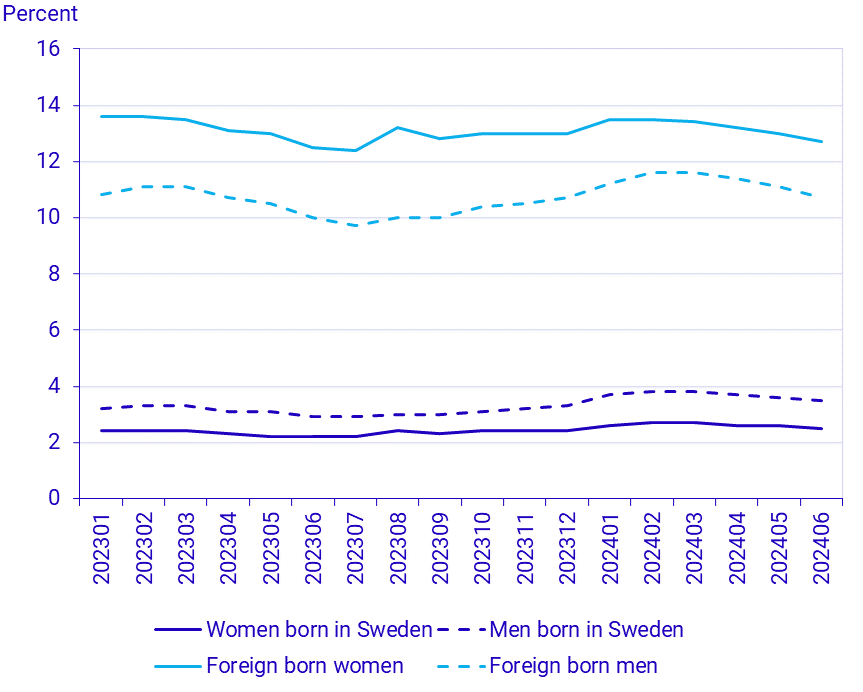Population by Labour market status, June 2024
The subdued state of the labour market continues in June 2024
Statistical news from Statistics Sweden 2024-08-30 8.00
People in employment aged 15 to 74 numbered 5 257 000 in June 2024. This is a decrease of 10 000 people compared with June 2023. In the 20 to 65 age range, 266 000 people were unemployed. This equals a share of 5.2 percent expressed as a percentage of the labour force and is an increase of 0.5 percentage point compared with the same period of the previous year.
People in employment
The number of people in employment aged 15 to 74 decreased in June 2024 by 10 000 compared with the same period of 2023, amounting to 5 257 000. Fewer women than men were employed. A total of 2 568 000 women and 2 689 000 men were employed.

In the 20 to 65 age range the employment rate – the number of employed people in relation to the population – was 80.4 percent in June 2024. The employment rate among women was 80.2 percent and 80.6 percent among men. Compared with June 2023, the employment rate was unchanged among women, while the employment rate among men decreased by 0.4 percentage points.
The unemployed
The number of unemployed people aged 20 to 65 in June 2024 was 266 000, which is an increase of 24 000 compared to the same period the previous year. A total of 126 000 women and 140 000 men were unemployed.
The relative unemployment rate - the proportion of unemployed people in relation to the labour force - was 5.0 percent for women and 5.3 percent for men. This equals an increased unemployment rate among woman of 0.3 percentage point, and 0.6 percentage point among men compared with the same period of 2023.
Unemployment is higher among foreign born people than among those born in Sweden. The relative unemployment rate was, among foreign born people, 12.7 percent for women and 10.7 percent for men. For people born in Sweden the relative unemployment rates was 2.5 percent for women and 3.5 percent for men in June 2024.

| June 2024 | May 2024 | June 2023 | Change since June 2023 (%) | |
|---|---|---|---|---|
| Employed | 5 257 000 | 5 173 000 | 5 267 000 | ‑0.2 |
| Men | 2 689 000 | 2 652 000 | 2 703 000 | ‑0.5 |
| Women | 2 568 000 | 2 520 000 | 2 564 000 | 0.2 |
| Men born in Sweden | 2 069 000 | 2 040 000 | 2 083 000 | ‑0.6 |
| Women born in Sweden | 2 003 000 | 1 965 000 | 2 008 000 | ‑0.2 |
| Foreign born men | 619 000 | 612 000 | 620 000 | ‑0.1 |
| Foreign born women | 565 000 | 555 000 | 556 000 | 1.6 |
| June 2024 | May 2024 | June 2023 | Change since June 2023 | |
|---|---|---|---|---|
| Employed | 4 877 000 | 4 821 000 | 4 889 000 | ‑0.3 |
| Men | 2 499 000 | 2 476 000 | 2 514 000 | ‑0.6 |
| Women | 2 378 000 | 2 345 000 | 2 375 000 | 0.1 |
| Employment rate (%) | 80.4 | 79.4 | 80.6 | ‑0.2 |
| Men | 80.6 | 79.8 | 81.0 | ‑0.4 |
| Women | 80.2 | 79.1 | 80.2 | 0.0 |
| Men born in Sweden | 83.9 | 83.1 | 84.4 | ‑0.5 |
| Women born in Sweden | 84.8 | 83.7 | 85.0 | ‑0.2 |
| Foreign born men | 71.4 | 70.6 | 71.5 | ‑0.2 |
| Foreign born women | 67.6 | 66.6 | 67.1 | 0.5 |
| Unemployment | 266 000 | 271 000 | 242 000 | 10.0 |
| Men | 140 000 | 143 000 | 125 000 | 12.5 |
| Women | 126 000 | 127 000 | 117 000 | 7.5 |
| Men born in Sweden | 69 000 | 70 000 | 58 000 | 18.0 |
| Women born in Sweden | 48 000 | 48 000 | 41 000 | 15.7 |
| Foreign born men | 71 000 | 73 000 | 66 000 | 7.5 |
| Foreign born women | 78 000 | 80 000 | 76 000 | 3.0 |
| Relative unemployment rate (%) | 5.2 | 5.3 | 4.7 | 0.5 |
| Men | 5.3 | 5.5 | 4.7 | 0.6 |
| Women | 5.0 | 5.1 | 4.7 | 0.3 |
| Men born in Sweden | 3.5 | 3.6 | 2.9 | 0.5 |
| Women born in Sweden | 2.5 | 2.6 | 2.2 | 0.3 |
| Foreign born men | 10.7 | 11.1 | 10.0 | 0.7 |
| Foreign born women | 12.7 | 13.0 | 12.5 | 0.2 |
| June 2024 | May 2024 | June 2023 | Change since June 2023 (%) | |
|---|---|---|---|---|
| Students | 41 000 | 183 000 | 37 000 | 9.6 |
| Men | 18 000 | 81 000 | 16 000 | 11.0 |
| Women | 23 000 | 103 000 | 21 000 | 8.5 |
| Retirees | 75 000 | 76 000 | 96 000 | ‑21.8 |
| Men | 38 000 | 38 000 | 47 000 | ‑20.2 |
| Women | 37 000 | 38 000 | 48 000 | ‑23.2 |
| Sick | 226 000 | 227 000 | 221 000 | 2.3 |
| Men | 101 000 | 102 000 | 99 000 | 2.5 |
| Women | 125 000 | 125 000 | 123 000 | 2.1 |
| Others | 583 000 | 490 000 | 581 000 | 0.4 |
| Men | 306 000 | 263 000 | 304 000 | 0.7 |
| Women | 277 000 | 227 000 | 277 000 | 0.0 |
Definitions and explanations
BAS, Population by Labour market status, presents statistics based on administrative data concerning aspects such as number of people in employment, unemployed people, and people outside the labour force for the registered population aged 15 to 74. The statistics can be used to describe current status, but also the progression over time. It illuminates both the entire population and smaller groups, such as detailed age groups at the municipal level.
The statistics contain estimates of the number of people broken down by labour market status: Employed, unemployed, student, retiree, sick and others. The definition of labour market status is hierarchical, which means that a person can only be assigned one labour market status, and it is determined according to the order of precedence above.
The labour force consists of employed people and the unemployed.
The labour market status categories that are outside the labour force are student, retiree, sick and others. There are fewer people outside the labour force in the summer than during other parts of the year. This is mainly because some people who are students during term time work during the summer and are then classified as employed.
Feel free to use the facts from this statistical news but remember to state Source: Statistics Sweden.
